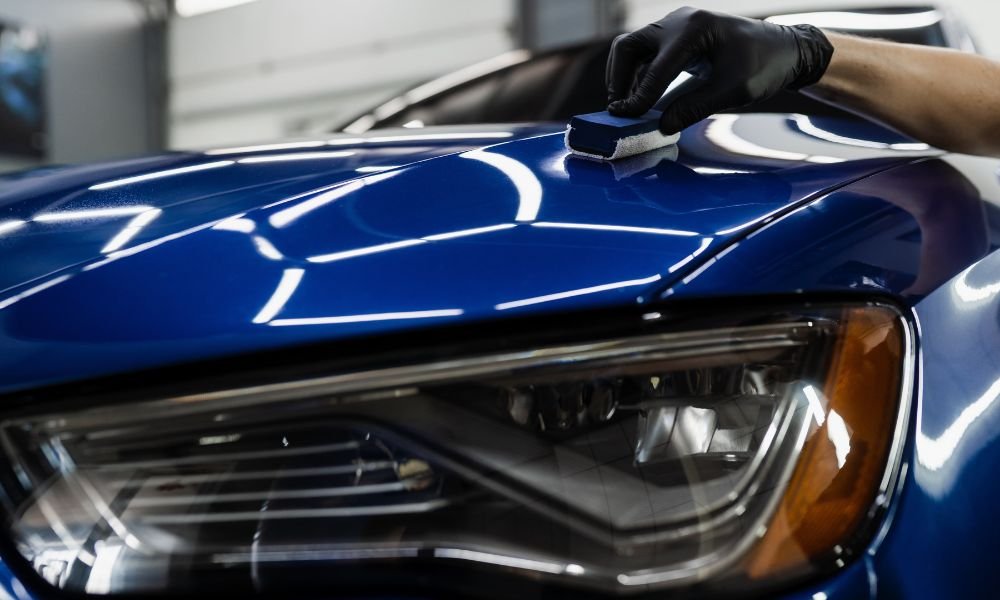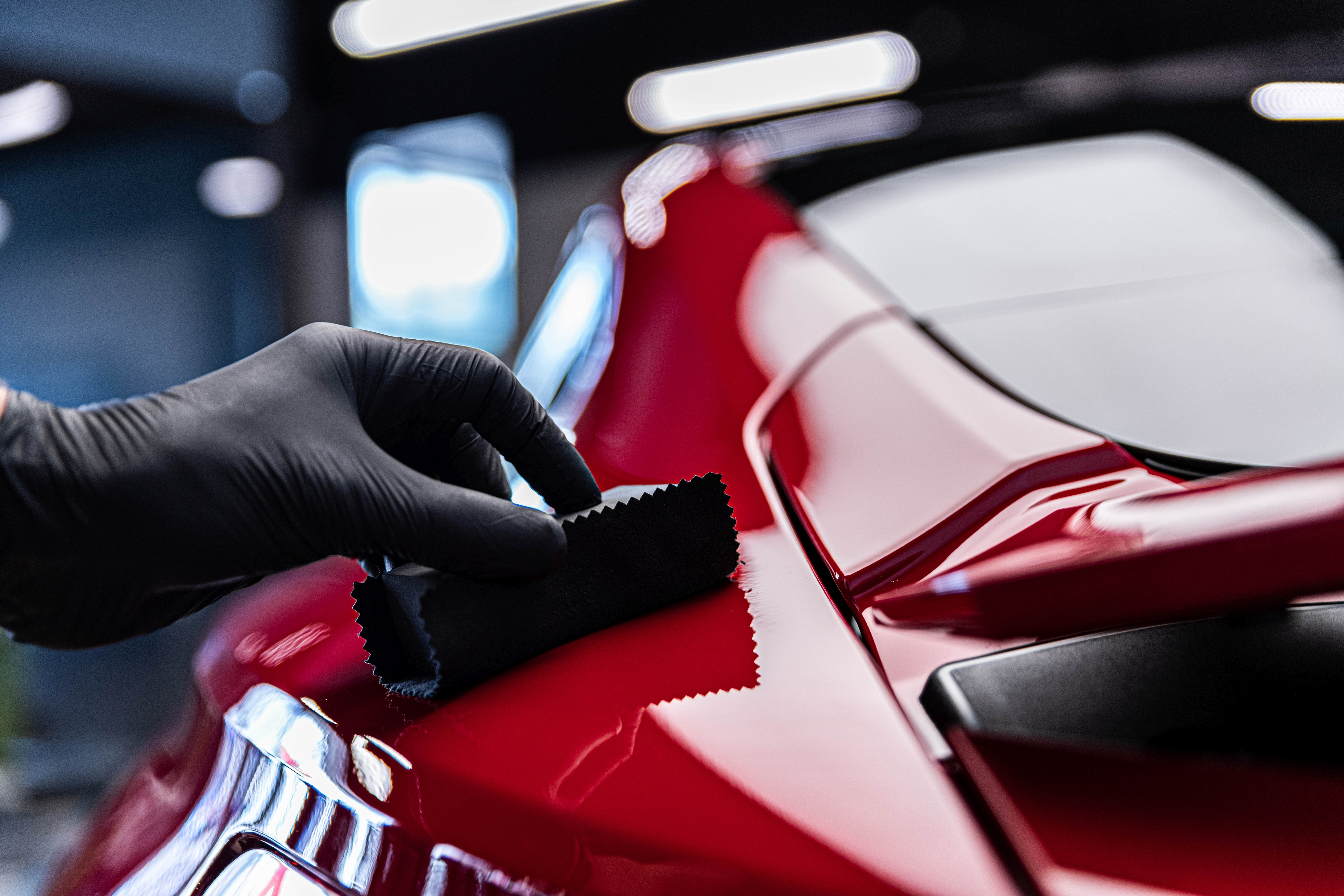Exploring the Science Behind Car Ceramic Coating and Its Protective Properties
The science of car ceramic coating presents a fascinating research in advanced automobile security. Made up mainly of silicon dioxide and polymers, these finishings develop a robust bond with lorry paint. This communication enhances longevity against ecological risks while offering hydrophobic advantages. The ins and outs of exactly how these coatings work and their long-term advantages stay less understood. Ceramic Coating Newark. Unloading these information reveals why ceramic finishes are ending up being a recommended option for vehicle treatment
What Is Ceramic Coating?
Ceramic coating is a fluid polymer that chemically bonds to the surface area of a car's paint. This advanced safety layer enhances longevity and offers superior resistance to ecological elements. Unlike conventional wax or sealers, which supply short-term security, ceramic layers develop a lasting shield that can endure rough problems such as UV rays, acidic contaminants, and severe climate. When used properly, the coating forms a hydrophobic surface area, triggering water to grain and slide off, which aids in keeping the car's sanitation. Additionally, it uses boosted gloss and depth to the paint, making the automobile appear more polished and vibrant. The application process usually includes detailed surface area prep work, including cleaning and sprucing up, to guarantee peak bonding. Consequently, ceramic finishings are ending up being progressively prominent among car fanatics and those seeking to secure their investments, assuring to maintain the vehicle's aesthetic allure while decreasing the regularity of upkeep.
The Composition of Ceramic Coatings
The complex solution of ceramic layers primarily includes silicon dioxide (SiO2), which is derived from all-natural resources like quartz and sand. This key component offers the foundation for the coating's toughness and protective qualities. Along with SiO2, ceramic coverings frequently consist of various polymers and ingredients that boost attachment, flexibility, and resistance to environmental aspects. These substances work synergistically to create a robust barrier against pollutants such as dirt, chemicals, and UV rays.Furthermore, some formulations integrate titanium dioxide (TiO2) or other nanomaterials, which can enhance the coating's hydrophobic properties, leading to enhanced water repellency. The specific composition can differ significantly amongst manufacturers, influencing performance and long life. Inevitably, the mix of these aspects culminates in a protective layer that not only boosts the visual allure of automobiles yet likewise serves to extend their life expectancy by shielding the surface area from potential damage.
How Ceramic Coatings Job
Understanding exactly how ceramic layers work entails discovering their chemical composition, which adds to their protective top qualities. The application process is necessary for attaining optimal outcomes, while durability and sturdiness aspects determine the coating's efficiency with time. Together, these aspects highlight the advantages and efficiency of ceramic finishings for automobile defense.
Chemical Make-up Explained
While several car proprietors look for lasting protection for their cars, the chemical structure of ceramic coatings plays a vital function in their performance. These coatings mainly contain silicon dioxide (SiO2), which is originated from all-natural minerals. This substance creates a solid bond with the lorry's paint, producing a long lasting, safety layer. Additionally, several ceramic finishes have titanium dioxide (TiO2), enhancing their hydrophobic buildings and resistance to UV rays. The visibility of polysiloxanes can better enhance flexibility and sturdiness. With each other, these elements add to the coating's ability to fend off water, dust, and contaminants, while likewise giving a high-gloss surface. Comprehending this chemical foundation helps car proprietors value the durable protection used by ceramic finishings.
Application Process Review
Using ceramic finishings involves a thorough process that assures ideal bonding and protection for the lorry's surface. At first, comprehensive cleaning and purification of the car's outside are done to get rid of dust, gunk, and previous waxes. This action verifies that the Visit This Link surface area is without impurities that could hinder bond. Following this, the paint is frequently polished to improve quality and remove any blemishes. As soon as prepared, the ceramic coating is used in tiny sections making use of an applicator pad, enabling consistent coverage. The coating is then delegated heal, creating a solid chemical bond with the surface area. Proper healing times and problems are critical, as they validate the coating accomplishes its maximum performance and safety qualities.
Long Life and Toughness Aspects
Ceramic finishes are developed to offer lasting defense through their sophisticated chemical make-up, which creates a robust barrier versus ecological impurities. The toughness of these layers is influenced by variables such as the density of the application, the quality of the product, and the conditions under which the automobile is exposed. High-grade ceramic coatings can last numerous years, standing up to scrapes, UV rays, and chemical stains. Correct upkeep, consisting of routine washing and regular reapplication, can even more enhance longevity. In addition, environmental elements like climate and direct exposure to contaminants can impact the lifespan of the coating. On the whole, when applied and kept correctly, ceramic finishes you could try these out provide remarkable longevity, making them a prominent selection for car fanatics looking for to preserve their vehicle's appearance.
Hydrophobic Qualities and Water Repellency
Hydrophobic homes are a hallmark of top quality car ceramic finishes, significantly boosting the automobile's surface efficiency. These finishings produce a molecular bond with the car's paint, resulting in a surface area that fends off water efficiently. When water enters contact with a ceramic-coated surface area, it beads up and rolls off, decreasing the quantity of liquid that remains on the paint. This habits not just adds to a cosmetically pleasing appearance but also decreases the buildup of pollutants such as dirt, gunk, and roadway salts.The boosted water repellency brings about much easier cleaning and upkeep, as less initiative is called for to remove unwanted compounds. Additionally, the hydrophobic nature of ceramic coatings aids in stopping water spots, which can mar the surface of uncoated surface areas. On the whole, the consolidation of hydrophobic residential or commercial properties in ceramic layers plays a vital duty in keeping the automobile's pristine look while simplifying upkeep.
Defense Versus Scratches and UV Damages
Car ceramic coverings provide considerable security versus scrapes and UV damage. The scrape resistance mechanism creates a sturdy layer that absorbs influences, while the UV securing advantages help keep the automobile's paint honesty in time. Together, these features add to a longer-lasting and visually appealing surface.
Scratch Resistance Mechanism
Utilizing innovative innovation, ceramic coverings offer a durable guard against scrapes and UV damages, boosting the durability and look of car surfaces. The scratch resistance mechanism of these finishes is connected to their distinct molecular structure, which forms a durable bond with the lorry's paint. This bond develops a hard, protective layer that can absorb influences and withstand abrasions. Furthermore, the smooth surface of the coating lowers friction, making it hard for contaminants to stick and trigger scrapes. The chemical composition of ceramic coatings often consists of nanoparticles that reinforce the protective layer, additional enhancing its resilience. Cars treated with ceramic finishes show substantially improved scratch resistance compared to conventional wax or sealers, ensuring an excellent finish over time.
UV Shielding Conveniences
The protective high qualities of ceramic layers prolong beyond scratch resistance to consist of considerable UV shielding advantages. These finishes produce a durable barrier that mirrors damaging ultraviolet rays, safeguarding the automobile's paint and underlying materials. Long term exposure to UV radiation can cause fading, oxidation, and damage of the paint finish. By incorporating ceramic coatings, automobile proprietors can properly minimize these dangers, maintaining the aesthetic allure and integrity of their cars and trucks. Additionally, the UV blocking properties add to boosted longevity, decreasing the regularity of repainting and upkeep. Ultimately, the integration of ceramic layers offers a complete remedy for shielding vehicles from the harmful results of sunlight direct exposure, guaranteeing a sustained, vivid look in time.
The Long life and Maintenance of Ceramic Coatings

Often Asked Concerns
Can Porcelain Coating Be Applied to Any Sort Of Car?
Ceramic coating can be related to various sorts of cars, consisting of autos, trucks, and bikes. Nevertheless, surface area preparation and compatibility with details materials are necessary for excellent bond and performance of the coating.
Just How Much Does Ceramic Coating Generally Expense?
Ceramic coating commonly sets you back between $500 and $2,000, relying on elements such as lorry dimension, coating top quality, and specialist application. The financial investment can provide lasting protection and improve the vehicle's appearance in time.

Is Professional Application Essential for Finest Results?
The necessity of professional application frequently depends upon preferred results. Experts normally assure proper surface area prep work and application strategies, resulting in ideal bonding and long life of the coating, which might be challenging for inexperienced people to achieve.
Can Ceramic Coatings Be Eliminated or Fixed?
Ceramic finishings can be removed or repaired, though the process may require particular solvents or strategies - Ceramic Coating Newark. Appropriate removal is important to stay clear of damages to the underlying surface, highlighting the significance of professional support for optimal outcomes
How Does Porcelain Coating Compare to Typical Wax?
The comparison in between ceramic coating and conventional wax reveals that ceramic coverings offer exceptional resilience, improved defense against ecological impurities, and longer-lasting luster, while wax needs more frequent application and offers less overall resistance to damages.